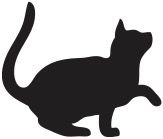A cat — especially an older cat — that displays a voracious appetite but continues to lose weight should be examined without delay by a veterinarian. It’s possible that the cat is afflicted with hyperthyroidism, a serious abnormality of the endocrine system. If hyperthyroidism persists and remains untreated, a cat can eventually become perilously emaciated, no matter how much food he eats.
This disorder is caused by a malfunctioning thyroid gland, which regulates an animal’s overall metabolism — the rate at which all of its bodily processes are carried out. The gland accomplishes this by secreting two vitally important hormones, thyroxine and triiodothyronine — commonly referred to as T4 and T3 — which circulate through a cat’s system and stimulate sensors on the internal organs. When the thyroid is operating properly, an animal’s metabolic rate is smoothly maintained. But when the gland secretes too much T4 and T3, all of a cat’s bodily processes will speed up dramatically — a process that can have life-threatening consequences.
The feline thyroid gland is relatively small — typically less than an inch in length — notes Orla Mahony, MVB, a specialist in internal medicine in the department of clinical sciences at Tufts. “It consists of two lobes,” she says, “that lie along the upper part of the trachea. The lobes are usually connected by a narrow bridge of thyroid tissue — which has no function — although they are sometimes completely separate.”
Hormone secretion, which is controlled by the pituitary gland in the brain, is the thyroid gland’s essential function, Dr. Mahony points out. These hormones are responsible for maintaining a level of metabolism in tissues that is optimal for normal function. A cat can live without these hormones, she says, but it definitely needs them in order to maintain a proper metabolic rate. In hyperthyroidism, the metabolic rate will rise, which can cause the heart to beat at an increased or irregular speed. The chronically elevated heart rate can induce cardiomyopathy, a potentially life-threatening disease of the heart muscle. Also, an affected cat can develop high blood pressure, and increased blood flow can cause its kidneys to overwork. “Eventually,” says Dr. Mahony, “this puts excessive strain on all of the animal’s tissues.”
The signs to watch for
The clinical signs of hyperthyroidism include increased appetite accompanied by weight loss; increased water consumption and urination; vomiting and diarrhea; labored breathing; and poor hair coat. Although most affected cats will become hyperactive, some may be lethargic, Dr. Mahony points out. “The condition can progress for quite some time,” she says, “and some cats may not be noticeably sick until they exhibit marked weight loss and other obvious signs of the disorder. Instead of sleeping, an affected animal might gradually become more active — anxious and restless — during the night. And about 10 percent of affected cats will have a high respiratory rate, so panting is also a sign of hyperthyroidism.”
For reasons that are still unknown, hyperthyroidism in cats is usually caused by the emergence of an adenoma (a noncancerous growth) that develops in the gland, although in very rare cases — perhaps three percent or so — the condition may be brought on by a cancerous tumor (carcinoma). Regarding the causes of these growths, Dr. Mahony says: “This is poorly understood at present, although possible risk factors that have been identified in various studies include the consumption of canned cat food — especially liver-, fish-, and giblet-flavored food. There’s also some concern that an iodine deficiency or a variation in the iodine content of the canned food that a cat consumes during its lifetime could be a risk factor.” Still another theoretical risk factor, she notes, is the ingestion of chemicals that line “pop-top” cat food cans
Advanced age is also known to be a significant risk factor for hyperthyroidism, says Dr. Mahony. “It’s clearly a disease of older cats,” she says. “The mean age of cats diagnosed with the condition is about 13 years, and it has been identified in cats as old as 24. However, the condition has also been diagnosed in cats as young as four years of age. So the range is huge.” Also, she notes, breed may play a role, since Himalayan and Siamese cats seem to have a lower risk of becoming hyperthyroid. There is no gender predilection, however, she adds.
“A cat can probably live with this condition for years,” says Dr. Mahony. “But it will not feel well. It’s a very debilitating disease, and a cat’s survival time will depend in part on what concurrent diseases it has. If, for example, the animal has heart disease, hyperthyroidism will exacerbate it.”
A tentative diagnosis of hyperthyroidism is confirmed by detecting a high level of the T4 hormone circulating in an affected cat’s blood. Just a single blood test will definitively diagnose the disorder in 90 percent of cases. For many veterinarians, says Dr. Mahony, this test is done as one part of a routine geriatric screening. If diagnosed, the condition can be treated medically, surgically or with radioactive iodine. A fourth option involves dietary measures.
Medication as treatment
Medical treatment typically consists of the administration of a drug called methimazole in pill form two times per day. This medication will block the secretion of thyroid hormones but will not remove or destroy a tumor responsible for the condition. Thus, while effective in retarding disease progression, it is not a cure. Surgical treatment, which will remedy the hyperthyroid condition, involves removal of all or most of the gland. Unfortunately, while the thyroid gland is easy enough to remove, there are other glands — the parathyroid glands — located near the thyroid and even partly within the gland itself. These tiny parathyroids regulate a cat’s calcium levels, and if they are damaged or removed by accident during surgery, the animal may become subject to low calcium levels that will require medical management.
The third option, treatment with radioactive iodine, is comparatively simple, consisting of a single dose of that chemical element. The iodine is usually administered by means of an injection just under the skin, although it may be given orally or intravenously. This treatment is safe and extremely effective, and it is likely to permanently cure a cat’s hyperthyroidism. “However,” observes Dr. Mahony, “although radioactive iodine treatment is becoming more affordable, like surgery, it requires a high upfront expense on the part of an owner, and not everybody is willing to make such a large financial commitment.” (See sidebar on page 12.)
Latest: nutritional support
The latest breakthrough in treatment, she points out, has been the relatively recent development of a novel prescription diet designed specifically to treat hyperthyroidism. Called Hill’s Prescription y/d, this product has been commercially available in both canned and dry form since late 2011. “It’s a diet that is so restricted in iodine that a cat can’t form the thyroid hormone T4,” explains Dr. Mahony. “Studies show that it works, so this is an alternative to medication. It’s an exclusive diet; a cat that is put on it cannot consume anything else — a treat, for instance, or a medication that might contain just a trace of iodine.”
In view of this diet’s development and commercial availability, Dr. Mahony considers feline hyperthyroidism to be, “a very treatable condition.” — Tom Ewing



